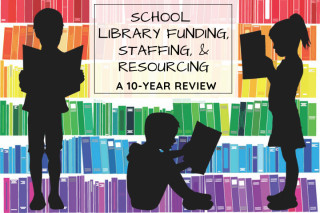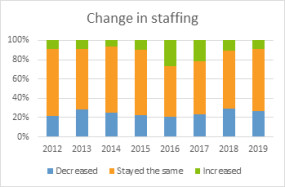- Your School Type
- Solutions
- Resources
- Blog
- Events
- More
- Contact Us
- Book a Demo
- Get a Quote

First published in ACCESS, Volume 34, Issue 3, September 2020.
To download a print-friendly copy of this article, click here.
In 2010 the Australian Federal Government launched an inquiry into the role, adequacy and resourcing of school libraries and teacher librarians in Australia’s public and private schools. Submissions were open to all interested organisations and individuals Australia-wide.
During the announcement of the enquiry, committee chair Ms Sharon Bird, MP, said:
“Teacher librarians make a significant contribution to the school community in a number of ways, including teaching information literacy skills and providing access to information and resources to facilitate learning.”1
To present an informed response that represented the voice of school library staff, Softlink ran the 2010 School Library Survey. Nathan Godfrey, Softlink’s Managing Director in 2015, said:
“We wanted to contribute to the Inquiry to support school libraries in Australia and, given that about one in two schools in Australia uses a Softlink product, we felt that we could contribute something unique.”
In Softlink’s submission to the Inquiry, the following recommendations were made:
It has been ten years since the Inquiry, and the same still rings true. This article will explore the findings of the Inquiry and review findings of the Annual Softlink School Library Survey since then.

The Inquiry was opened in March 2010, to be reopened in November 2010 after the Federal Election.
During the announcement of the enquiry, Committee Chair Ms Amanda Rishworth, MP, said:
“The Committee is very pleased that this matter will be revisited by the new Education Committee. Teacher librarians make a significant contribution in our schools and we look forward to sharing our findings on how to enhance this valuable community resource.”2
The focus points of the inquiry were:
The inquiry received 387 submissions that lead to 11 recommendations3:
Other points of interest shared in the Overview were that4:
The full report is available here.
It has been ten years since these recommendations and observations were made. Over those ten years advocacy has grown, with ASLA and ALIA continuing to support and promote school libraries, and groups such as Students Need School Libraries Campaign being launched.
Over these ten years, Softlink has continued to run an Annual School Library Survey which helps to build a critical reference point for understanding changes, impacts and trends over time while providing a solid basis for school library advocacy. In the blog post “To supercharge student success: start with a great school library” Holly Godfree, Students Need School Libraries Campaign Coordinator, said,
“I would argue that Softlink’s School Library Survey is actually the only solid, concrete outcome from the Senate Inquiry.”
What have responses to the School Library Survey shown since the initial submission to the Inquiry in 2010?
NOTE: Although the Annual School Library Survey has also expanded to include the voice of library staff from the Australia, New Zealand and Asia Pacific (APAC), and Europe, Middle East and Africa (EMEA) regions, the following only uses Australian data.
When asked “What is the one thing you would change about your library or role?” a recurring theme in the comments is that library staff would like to see an increase in budget to further develop their collection, refurbish the library, to improve services, to create makerspaces, and to introduce eResources.
“An increase budget would be amazing - so that our library is staffed and resourced in a way that can provide best practice for our staff and students.”
“We need a bigger budget to provide the students with more books and a makerspace.”
“I would like a larger budget to better deliver resources to the needs of the students.”
“I would love to implement eBooks/eResources but our budget is small.”
“I would like a bigger budget to respond to changing curriculum needs and student reading abilities and needs.”
“I would like more money to purchase resources to replace the aging ones I have.”
“We are a small, low socioeconomic school so the budget is very tight, I would love to see the government realise that our little libraries are just as important as large ones. Our students probably need the resources more as they do not have them in their homes.”

From 2011 to 2019, budgets have remained fairly stable with 52% - 56% of respondents indicating that their budget was unchanged, and 19% - 22% of respondents indicating that their budget had increased. Reported budget decreases were more diverse, ranging from 19% to 33%.
Reasons given for budget increases include a change of principal or business manager, new resources to support a new curriculum, library refurbishment, new furniture, an increase in enrolments, and one-off grants.
Reasons given for budget decreases include a change of principal, general tightening of the whole school budget, a decrease in enrolments, one-off grants being given the previous year, and money being required elsewhere in the school.
Other recurring themes when participants were asked “What is the one thing you would change about your library or role?” were an increase in staff numbers, increase in hours, increase in qualified library staff or an increase in dedicated time in the library.
“We need more time to perform role as it should be performed and to teach library and research skills. I would love to have a full time and a part time staff member in the library.”
“I would like a library assistant paid for a full day instead of 2 hours a week. There is never enough time to do book displays, weeding, re-classifying, and presentation of the library.”
“I would like to increase staffing hours so I have time to contribute more to student learning outcomes.”
“If another person were to work with me (even for a day), we could potentially accession new resources quicker and help staff gather much needed resources for their lessons etc.”
“I would have a 50% or even 100% library assistant to keep on top of cataloguing, purchasing and general library organisation to allow the TL to plan and deliver quality teaching and assistance to staff.”
“I would like an increase in staffing so that the library can open 5 days a week.”

Most years have seen 9% - 11% of respondents indicate an increase in staffing, with decreases being more varied ranging from 21% - 28%. 2016 and 2017 saw a more dramatic increase in staffing numbers, with 27% and 26% of respondents indicating a rise. All other years, twice as many schools reported a decrease in staffing as reported an increase.
In 2018 and 2019, we added a question to the survey asking whether school libraries have at least one qualified teacher librarian or qualified librarian working in the library.
65% of respondents in 2018 and 52% in 2019 indicated that they had a qualified teacher librarian working in their library; 13% in 2018 and 12% indicated that they had a qualified librarian on staff.
With fake news on the rise and a growing need to connect students with high quality resources (as opposed to a Google search) it is not surprising that recommendations to the Government inquiry included funding for online databases in all Australian schools.
Respondents to the School Library Survey shared:
“Databases are an exciting development that should be further explored.”
“I would like to see centralisation of providing resources – e.g. the Department could have a license to access databases that all libraries could access.”
“With access to online databases, research can happen easily and more regularly.”
In 2015, we introduced a question to find out how many schools subscribed to online databases. 44% of respondents indicated that they have online databases; this grew to 48% in 2019.
When looking at access to online databases according to the school’s education provider, 61% of Catholic school respondents, 37% of Government school respondents, and 73% of Independent school respondents reported that they were available in their library.

The Survey also asks about the key services or objectives of the school library, and what respondents would like to provide more of if they had the time or resources.
The top three services have consistently been:
The top three services respondents would like to provide more of include:
While the survey looks at a range of statistical data, which helps to build a reference point for advocacy, an important function of the survey is the avenue it provides for school library staff to share opinions and ideas. As shared by one respondent to the 2019 survey,
“I would like to thank Softlink for providing access to this survey and allowing library professionals to have a voice, as well as providing a valuable tool for advocacy. I very much look forward to reading the results of this survey next year.”
Every year we pose three open-ended questions at the end of the survey to help facilitate this. The answers are then collated and used to create feature documents based on common themes as they emerge.

To date we have produced 10 feature documents around the themes of challenges school libraries face, opportunities, trending topics, innovative ideas, promoting the library, collaboration and more.
Our most recent feature document What’s trending #SchoolLibraries 2019-2020 includes global comments from the 2019 survey, as well as responses to a mini COVID-19 survey we ran in May 2020. For a summary of feature documents from previous years read Softlink’s School Library Survey Feature Documents available on the Softlink blog.
1. House of Representatives Standing Committee on Education and Training, Media Release 18 March 2010, retrieved from https://www.aph.gov.au/parliamentary_business/committees/house_of_representatives_committees?url=ee/schoollibraries/media/media01.pdf
2. House of Representatives Standing Committee on Education and Training, Media Release 25 November 2010, retrieved from https://www.aph.gov.au/parliamentary_business/committees/house_of_representatives_committees?url=ee/schoollibraries/media/media11.pdf
3. House of Representatives Standing Committee on Education and Training, School libraries and teacher librarians in 21st century Australia, retrieved from https://www.aph.gov.au/Parliamentary_Business/Committees/House_of_Representatives_Committees?url=ee/schoollibraries/report/front.pdf
4. House of Representatives Standing Committee on Education and Training, School libraries and teacher librarians in 21st century Australia Overview, retrieved from https://www.aph.gov.au/Parliamentary_Business/Committees/House_of_Representatives_Committees?url=ee/schoollibraries/report/chapter1.pdf